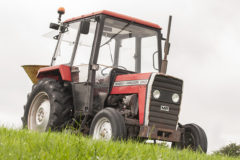1950 Mack LJT conservation
Posted by Chris Graham on 26th June 2022
Darron Wilson’s magnificent, 1950 Mack LJT is an ongoing conservation project. David Reed tells the story.
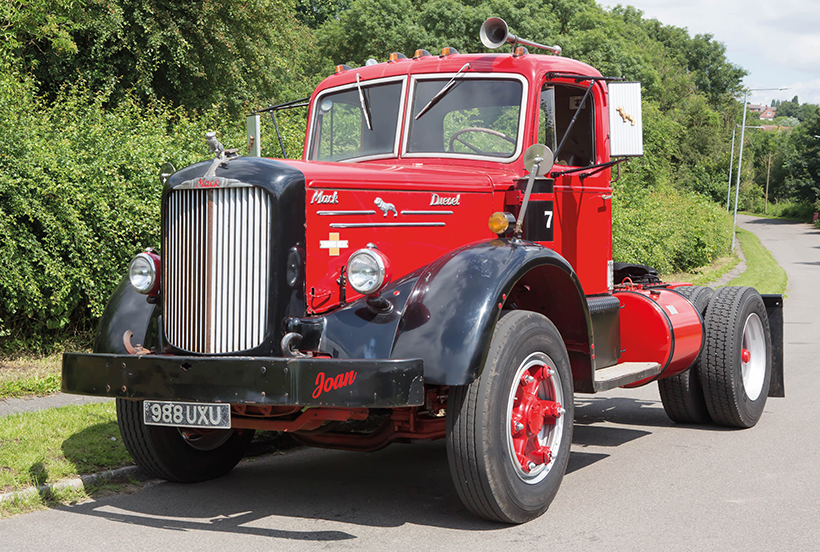
Darron Wilson’s magnificent, 1950 Mack LJT.
Last month, as part of our ongoing series of features marking the centenary of Scammell lorries, our cover starred Nottinghamshire-based Darron Wilson’s 1976 Scammell Crusader. However, that is not the only lorry Darron owns, and the Scammell is frequently seen at shows etc., alongside something rather different in many ways, but not in others. We’re referring to 988 UXU, a 1950 Mack LJT that spent its working life in America, and is preserved in, basically original condition.
The Mack is powered by a Cummins 200 engine with a ten-speed ‘twin-stick’ box and carries the chassis number of LJT1D 9638D.
Mack Trucks Historical Museum in Allentown, Pennsylvania confirm that the vehicle came off the assembly plant production line at Allentown on September 26 1950 and upon completion the chassis was assigned to the Mack Trucks Inc. factory branch at Charlotte, North Carolina. It was then delivered to North Carolina Garage Inc. in Winston Salem, North Carolina on September 30.
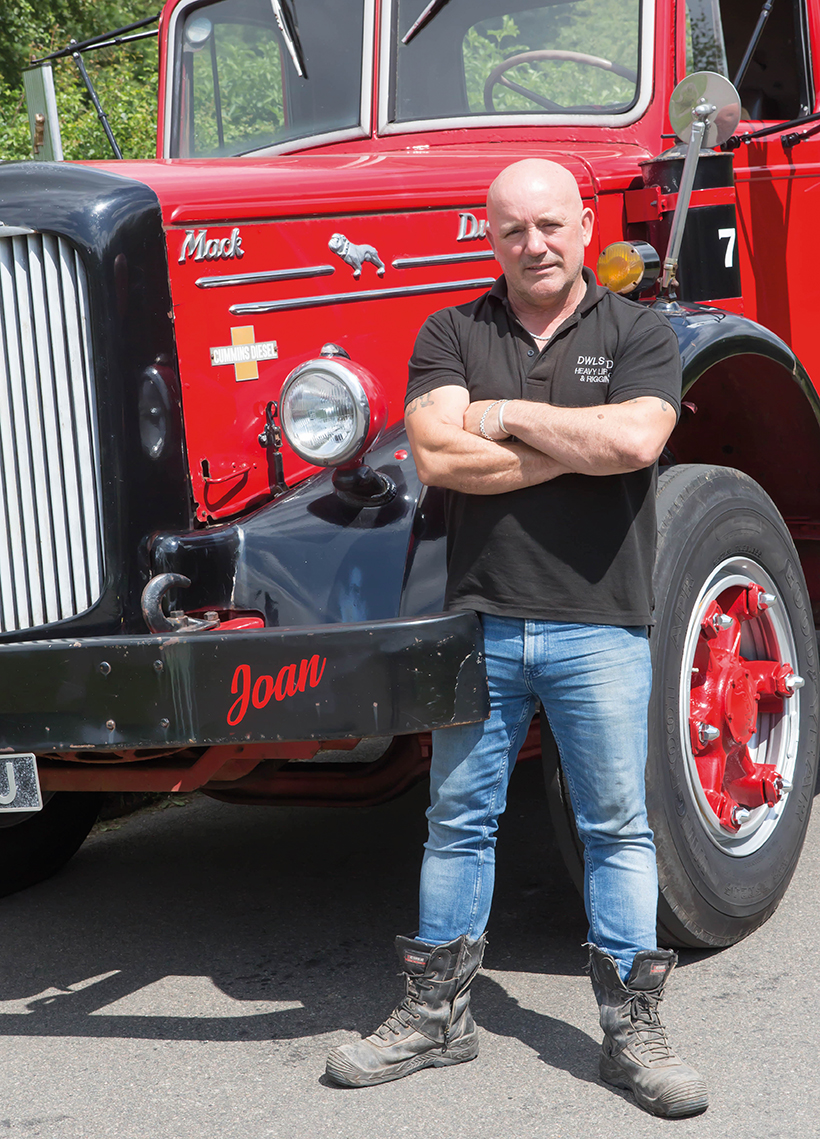
Owner Darron Wilson alongside his stateside truck.
“It was used in the USA on logging duties between New Jersey and Pennsylvania,” Darron said. “And it is reminiscent of those old 1950’s American films where lorries were central to the plot.” After its working life was over, the Mack was acquired by Tom Spencer in the early 1990s and was displayed in a Pennsylvania vintage railway museum where it was also used to move railway vehicles between the museum buildings.
After a period of storage, the Mack was bought by British-based Trevor Williams for import and ongoing preservation in the UK. It was taken to Baltimore in April 2005 from where it was shipped across the Atlantic. Arriving at Southampton on May 2006, the Mack was transported to Trevor’s base in Cambridgeshire. “The gearbox and most of the parts were all original,” Darron confirmed, “The only thing that it will have received was a little TLC and overhaul of the main working parts.”
While it was in Trevor’s ownership, the Mack was exhibited with a fifth wheel trailer at several shows including Pickering and Driffield as well as attending other events in Yorkshire. “I was intrigued by the Mack when I was told about it,” Darron said. It wasn’t long before Darron decided to go and have a look at it, but that wasn’t a particularly easy task. “It had been stored in a barn for between seven and ten years and was covered in cobwebs,” Darron said, “I couldn’t even get in the cab.”
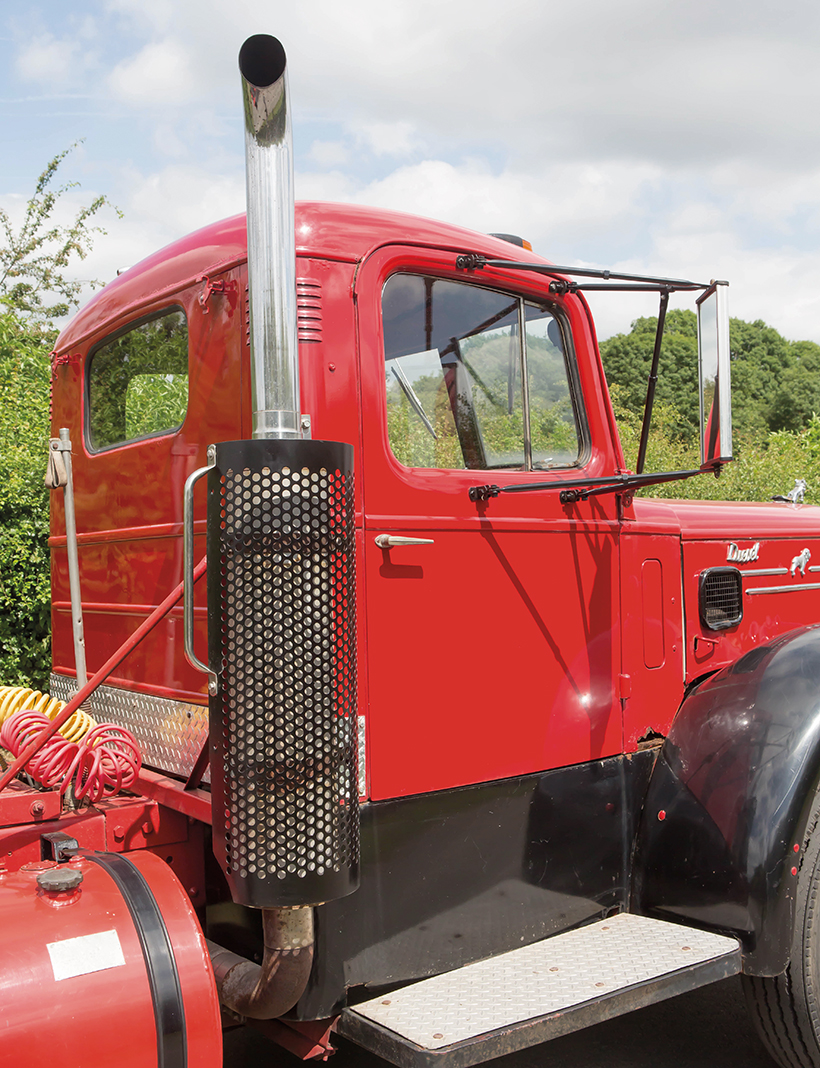
Classic stateside exhaust, though it seems strange for it to be on what would be the nearside in its homeland.
To get the Mack running, a couple of gallons of diesel were put in the tank and two batteries were fitted. Once that was done “it fired up straight away,” Darron said. “I just fell in love with it, and asked Trevor if he was willing to sell it.” Darron didn’t, however, get the answer that he wanted. “Trevor just said that it was not for sale, there was too much history attached to it,” he explained. But Darron’s perseverance eventually paid off. “Trevor finally agreed to sell it to me as he could see how much I loved the Mack,” he said.
With a deal being completed, Darron made the trip to Cambridgeshire with a low-loader to collect the Mack. “When I got the Mack home, I took it to a few shows just as it was”.
Conservation, not restoration
By the winter of 2018/19, Darron decided that it was time to do some work to his new acquisition. “I didn’t want to restore it, I wanted to preserve it,” he said, “Trevor was right, there is a lot of history associated with this vehicle.” Although this wasn’t going to be a full restoration, there was still a fair amount of work required, so Darron, with the help of life-long friend Andrew Craven, started to do some small bits and pieces to the Mack.
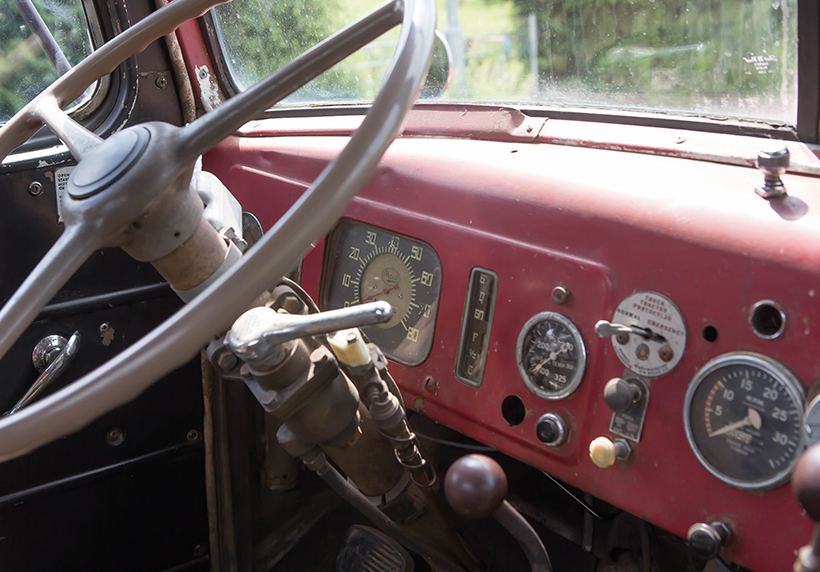
Classic stateside truck dash layout! Here too, conservation was the order of the day.
One of the first jobs to be tackled concerned the rear wheel hubs. “Both of them were leaking. So we stripped the back end out on both sides.” With everything being removed, Darron and Andy took the opportunity to do some other work under the wheel arches, “We stripped the dampers and spring hangers out and shot-blasted them,” Darron said. To complete the job, Darron and Andy re-sealed the hubs and then cleaned out the wheel arches with wire brushes, rotary brushes and a grinder before repainting everything and putting it all back together. The same procedure was carried out on the front wheels, “It was easier as these hubs were not leaking so didn’t have to be re-sealed,” Darron said. “We have now fitted new rear Mack mud flaps to the original hangers after refurbing them and will do all of the front mudguards and the bonnet this winter.”
The headlight pods also needed some attention, but in keeping with the rest of the vehicle, Darron and Andy wanted to keep the original ones, if possible, to retain the Mack’s authentic look. “There were some big holes in them, so we had to do a lot of fabrication work to get them back to original condition” Darron continued. It was not an easy job as the lights were cone shaped. “It took a lot of work to mould the metal to get them to the correct shape,” he added.
Both mirror arms also needed work. “They were rotten in places,” Darron explained, “So we cut out the bad bits and repaired them as required.” Also in need of some attention was the driver’s door, “The metal was in poor condition,” Darron added, “So we removed all of the rotten sections, then welded in new ones and repainted them.” It was a similar story with the floor where again parts were in poor condition and had to be repaired with new sections being added.
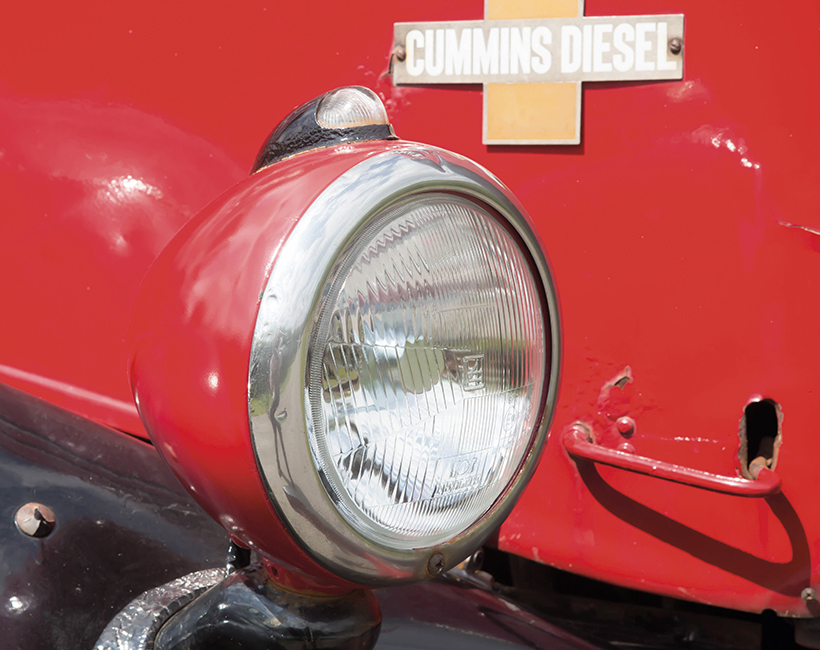
Headlight pods have been restored rather than renewed, as part of Darron’s policy of keeping everything as original as possible.
Almost everything else in the cab has, however, been left as it was, with the dashboard having that original patina that just can’t be replicated. “We don’t want to do anything else to it,” Darron continued, “We just want to leave it as it is.” The leather headlining inside the cab was in a poor state and had to be sent away to try to get it restored. “It will be going back in the cab when it’s been done,” Darron added. The restoration team did enjoy a little luck when they were dealing with the cab’s lining. “We found an old dollar bill tucked behind it,” Darron said, although who ended up with it was not revealed!
Andy Craven was given the task of sorting the electrics. “They were a nightmare,” he said, “The Mack is positive earth, and I had to go through every wire.” Although the system has all been checked, the job still hasn’t been completed, “It really needs a total rewire,” Darron admitted, “But it is a work in progress, and we will get it right.” Andy agreed.
Other work has included the rebuilding of both power take offs, which caused a few problems, “We had to get seals from the USA,” Darron admitted as both sides were leaking, When it came to the engine, it was given a good clean while a new water pump and belts were required. “We also had to look at the airbox under the bonnet,” Darron continued, “That was rotten too so we had to strip it all down and refurbish it, replacing the rotten parts and repairing as needed to keep it as original as we could.”
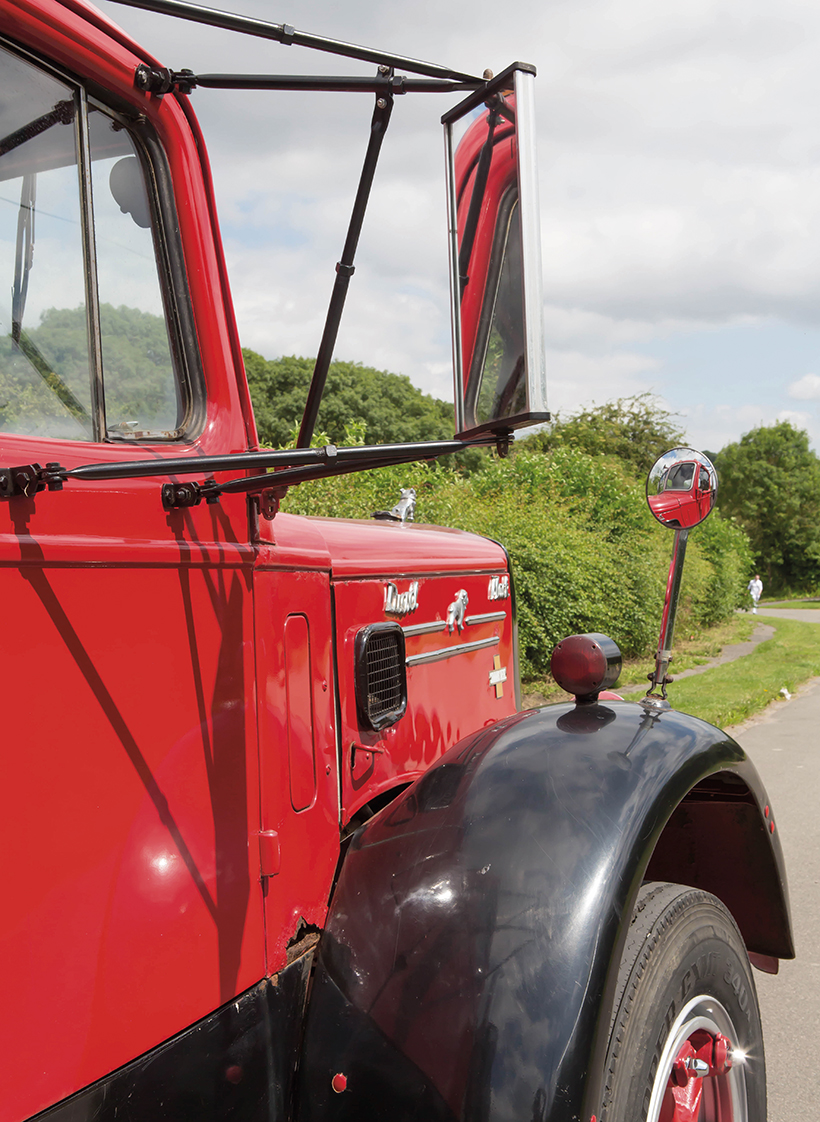
Cab doors and mirror-support bracketry required a fair amount of work, along with the cab floor.
As it turned out, the paint was one of the hardest things to find. “Matching it up to keep it as original as possible was very difficult,” Darron said, “We had three attempts just to get the colour right.”
The Mack is undergoing a rolling programme of repairs which will take a while to complete. It will still be seen at events though, so that other people can see the Mack during the restoration process. Darron and Andy’s aim concerning the vehicle’s restoration is clear. “We don’t want to take too much off it, we’re trying to improve and conserve it not restore it,” Andy said. “We are just doing it to preserve the vehicle, we want to keep its character,” Darron added.
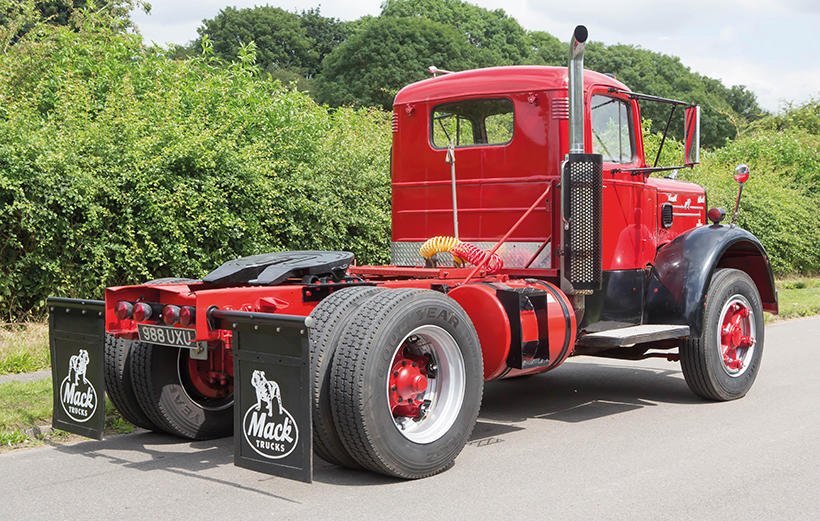
And that is an aim which many will, surely, applaud.
This article comes from the latest issue of Classic & Vintage Commercials, and you can get a money-saving subscription to the magazine simply by clicking HERE



